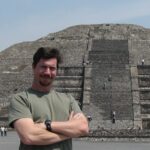Just before darkness, cold, and snow appeared last December we decided to try a new winter travel adventure. We purchased a “Great Course” called the Ancient Civilizations of North America that took us on a virtual trek across North America over a 10,000 year plus time.
The course contained 24 lectures on a CD with a paper book paralleling each class.
A Good Way to Enjoy Winter Evenings

Dr. Barnhart is the director of the Maya Exploration Center.
A few evenings a week we’d sit by our fireplace and enjoy a 30-minute lecture. Our professor was Dr. Edwin Barnhart, Director of the Maya Exploration Center. He’s also a Fellow of the Explorers Club and has traveled extensively. His knowledge of ancient cultures is extraordinary and his delivery impressive. As we watched him on our television it was as if he was speaking directly to us.
His course started with archeological terms and the first people known to cross the Bering Land Bridge and enter our continent in pursuit of mammoths and other gigantic now-extinct animals. Later lectures brought us forward in time to Native Americans along the East Coast just before Europeans arrived.
During the class, we “visited” such fascinating places as Chaco Canyon, Cahokia, Meadowcroft Rockshelter, and many others.
A Chat with Dr. Barnhart
Shortly after finishing his course, we had a delightful phone conversation with Dr. Barnhart. He lives in Austin, Texas, and was attempting to replace a water line that froze and bust in the late winter freeze that hit the Lone Star State and other southern states. Curious, we asked him a number of questions about archeology and how the Great Course we took was so effectively presented. Here were some of our questions and his responses:
- Do archeologists often have a feeling of awe when at a place where people lived hundreds or thousands of years ago? “Yes, very often.”
- We live in Iowa where ancient people often created large earthen mounds, often on high ridges above streams and rivers. Might we have mounds near our home above Indian Creek and how might we spot them? “The name Indian Creek sums it up. Yes. There might be mounds, but many may have been destroyed. Keep your eyes open. It’s important that these places be protected.
- When we mentioned that the area had been hit but a derecho’s 140 miles an hour wind that had uprooted many trees he responded, “Often artifacts are found in the root balls of uprooted trees. Look carefully at them and you might find stone tools or pieces of pottery.”
Keeping the Conversation Lively
- When we asked him about how he made his course delivery so interesting he replied, “We’ll I organized the class and its content but the technical people who did the filming for the Great Course are skilled in helping make and keep presentations interesting.” Among the aspects of the class and delivery that kept us fascinated were background murals that changed with each lecture, excellent graphics and maps, and Dr. Barnhart looking directly at us (the camera). He would also rotate about 90 degrees every ten or fifteen minutes and look at a different camera. Then he revealed a secret. Because he knew the material well and had written the script keeping a flow of conversation was easy. And, he quipped, “My notes were on a teleprompter.”
We thank Dr. Barnhart for his vast knowledge and ability to communicate it. We will take future Great Courses. They range from lifestyle topics to learning advanced calculus to European history and music. For information go to www.thegreatcourses.com.
Author note: We purchased and reviewed the Great Course on our own with no special consideration given to us.


It wasn’t through Great Courses but I took a course on classic children’s literature that was somewhat interesting. I have been eyeing the Great Courses for some time. After reading your review, I may have to order one.
That course sounds fantastic. I was tickled pink when I found an arrow head here at the Ridge House in Bedford. I wonder how many other ancient artifacts are hidden beneath the red clay. (: